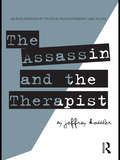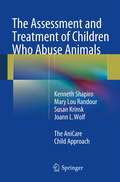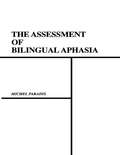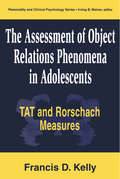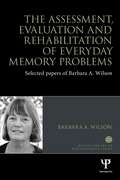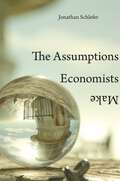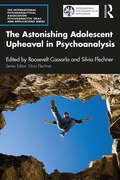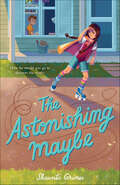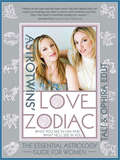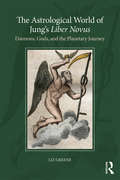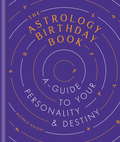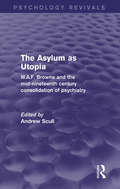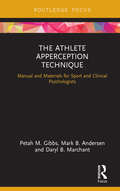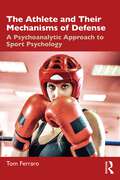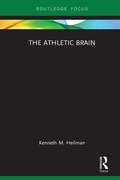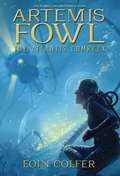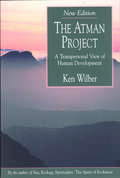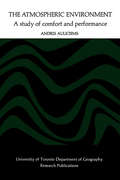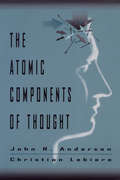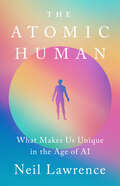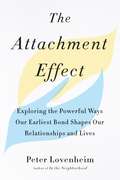- Table View
- List View
The Assassin And The Therapist: An Exploration Of Truth In Psychotherapy And In Life
by Jeffrey A. KottlerMany therapists have likely worked with a client who has caused the therapist to confront his most cherished beliefs, or has changed the therapist in ways that forever altered the way he performs therapy, looks at the world, and sees himself. The author of this book found himself in just such a situation, causing him to begin his own search for truth. This book is the result of his search; it explores the nature of truth in psychotherapy and in the therapist's life, examining some of the things that are often denied and rarely spoken about. This book contains two parallel narratives: the first tells the story of Jacob, a man in his seventies, who lived through one of the most dramatic periods in history and actually altered events through his acts of violence. Following him from his childhood to his recruitment, training, and life as an assassin, it is a tale of intrigue, of adventure and courage, but one that also raises a number of profound moral issues. The reader will find several unexpected but significant themes scattered throughout Jacob's story which, upon close examination, have significant implications for the ways therapists think about their work and their relationships with clients. The second narrative details the author's struggles as a therapist as he tries to make sense of his doubt, imperfections, and self-deceptions. The reader will join him on his search for truth in both psychotherapy and life. His story becomes a lesson for digging deep into the complex and ambiguous nature of what therapists do and what they think they learn in their work. A greatly unique and fascinating work, readers will find themselves both enthralled in and changed by Jacobs story and the author's journey.
The Assassin and the Therapist: An Exploration of Truth in Psychotherapy and in Life
by Jeffrey KottlerMany therapists have likely worked with a client who has caused the therapist to confront his most cherished beliefs, or has changed the therapist in ways that forever altered the way he performs therapy, looks at the world, and sees himself. The author of this book found himself in just such a situation, causing him to begin his own search for truth. This book is the result of his search; it explores the nature of truth in psychotherapy and in the therapist’s life, examining some of the things that are often denied and rarely spoken about. This book contains two parallel narratives: the first tells the story of Jacob, a man in his seventies, who lived through one of the most dramatic periods in history and actually altered events through his acts of violence. Following him from his childhood to his recruitment, training, and life as an assassin, it is a tale of intrigue, of adventure and courage, but one that also raises a number of profound moral issues. The reader will find several unexpected but significant themes scattered throughout Jacob’s story which, upon close examination, have significant implications for the ways therapists think about their work and their relationships with clients. The second narrative details the author’s struggles as a therapist as he tries to make sense of his doubt, imperfections, and self-deceptions. The reader will join him on his search for truth in both psychotherapy and life. His story becomes a lesson for digging deep into the complex and ambiguous nature of what therapists do and what they think they learn in their work. A greatly unique and fascinating work, readers will find themselves both enthralled in and changed by Jacob’s story and the author’s journey.
The Assessment and Treatment of Children Who Abuse Animals: The AniCare Child Approach
by Mary Lou Randour Kenneth Shapiro Susan Krinsk Joann L. WolfEmpirical research has clearly demonstrated that animal abuse in childhood is associated with family violence and violent behavior towards humans in general. Such abuse is accordingly of increasing interest within human services and the criminal justice system. This handbook will serve as an ideal resource for therapists in social work, psychology, psychiatry, and allied fields who work with children who have abused animals. It provides step-by-step guidance on how to assess, develop appropriate treatment plans for, and treat children who commit animal abuse, based on the AniCare model developed by the Animals and Society Institute. Exercises cover the identification and expression of feelings, the development of empathy, self-management skills, and working with parents. Careful consideration is also paid to the effects of witnessing animal abuse. The theoretical framework is eclectic, encompassing cognitive behavioral, psychodynamic, and attachment theories. A number of illustrative case studies are included, along with excerpts from treatment sessions. Accompanying electronic supplementary material demonstrates role-played assessment and treatment and includes workshop presentations of pedagogic material.
The Assessment of Bilingual Aphasia (Neuropsychology and Neurolinguistics Series)
by Michel Paradis Gary LibbenThe Bilingual Aphasia Test is a comprehensive language test designed to assess the differential loss or sparing of various language functions in previously bilingual individuals. The individual is tested, separately, in each language he or she previously used, and then in the two languages simultaneously. The testing is multimodal -- sampling hearing, speaking, reading, and writing; and multidimensional -- testing various linguistic levels (phonological, morphological, syntactic, lexical, and semantic), tasks (comprehension, repetition, judgment, lexical access and propositionizing), and units (words, sentences, and paragraphs). The BAT is structured as follows: * To test a bilingual aphasic, you will need the following testing elements: the stimulus books for each of the languages in which the individual was formerly fluent, the single-language tests for each of these languages, as well as the bilingual test that links them. For example, if you are testing an English-French bilingual aphasic, you will need an English stimulus book, a French stimulus book, an English single-language test, a French single-language test, and an English-French bilingual test. * The BAT can also be used to test monolingual aphasics. To test for monolingual aphasia, you will need the stimulus book and the single-language test in the language in which the individual was formerly fluent. * Professor Paradis' book, The Assessment of Bilingual Aphasia, provides the background material and serves as the manual for the test. The BAT is available in dozens of languages and language pairs. There are now 106 bilingual pairs available. Additional single-language and bilingual tests are being prepared continuously. If the language (or language pair) you need is not listed, please call LEA to find out if and when it will be available. Single-language materials are now available in: Amharic Arabic (Jordanian) Arabic (Maghrebian) Armenian (Eastern) Armenian (Western) Azari Basque Berber Bulgarian Catalán Chinese (Cantonese) Chinese (Mandarin) Croatian Czech Danish Dutch English Farsi Finnish French Friulian Galician German Greek Hebrew Hindi Hungarian Icelandic Inuktitut Italian Japanese Kannada Korean Kurdish Latvian Lithuanian Luganda Malagasy Norwegian Oryia Polish Portuguese (Brazilian) Portuguese (European) Rumanian Russian Somali Spanish (American) Spanish (European) Swahili Swedish Tagalog Tamil Turkish Ukrainian Urdu Vietnamese Yiddish Bilingual pairs are now available in: Amharic/English Amharic/French Arabic/Armenian Arabic/English Arabic/French Arabic/Somali Arabic/Swahili Armenian/English Armenian/Farsi Armenian/French Armenian/Russian Basque/English Basque/French Basque/Spanish Berber/English Berber/French Bulgarian/English Bulgarian/French Bulgarian/German Bulgarian/Russian Catalán/Spanish Chinese (Cantonese)/English Chinese (Mandarin)/English Chinese/French Croatian/English Croatian/French Croatian/Italian Czech/English Czech/German Czech/Russian Czech/Swedish Danish/English Danish/German Dutch/English Dutch/French Dutch/German Dutch/Hebrew English/Farsi English/Finnish English/French English/Friulian English/German English/Greek English/Hebrew English/Hindi English/Hungarian English/Icelandic English/Italian English/Japanese English/Korean English/Latvian English/Lithuanian English/Luganda English/Norwegian English/Polish English/Portuguese English/Rumanian English/Russian En
The Assessment of Object Relations Phenomena in Adolescents: Tat And Rorschach Measures
by Francis D. KellyThis book offers clinicians a long-awaited comprehensive paradigm for assessing object relations functioning in disturbed younger and older adolescents. It gives a clear sense of how object relations functioning is manifest in different disorders, and illuminates how scores on object relations measures are converted into a therapeutically relevant diagnostic matrix and formulation. Outlining the process of object relations assessment, Kelly presents vividly detailed cases of a range of disorders including anorexia nervosa, borderline states, depressive disorders, and trauma. The cases portray the vicissitudes of object relations functioning and disruption that result in a unique structural developmental composite for a given adolescent. A major concern is demonstrating the utility and validity of two object representation measures--The Mutuality of Autonomy Scale (MOA) and The Social Cognition Object Relations Scale (SCORS)--that are the main ones employed in the assessment of adolescents. MOA and SCORS scores facilitate a multidimensional understanding of the nuances of an adolescent's object relations functioning, and provide clinicians with organized, theory-based data leading to clear, specific treatment directions and guidelines and appropriate therapeutic programming. The book addresses the following questions: * Is individual psychotherapy indicated--will this adolescent benefit from an insight-oriented approach? * What are the likely directions that transference parameters will take in the treatment? * What types of countertransference reactions are likely to be anticipated in a given patient? * Is medication likely to be helpful in making this adolescent more accessible for treatment? Focusing only on adolescents, covering both the TAT and the Rorschach, and utilizing object relations theory as its major interpretive foundation, the book offers practitioners an alternative to general references based on a more actuarial, nomothetic, and atheoretical interpretive approach. It reflects one school of contemporary thought in projective assessment--one that advocates a more phenomenological, theory-based approach to test application and interpretation.
The Assessment of Psychosis: A Reference Book and Rating Scales for Research and Practice
by Flavie Waters Massoud StephaneThis book reviews the descriptive features of psychotic symptoms in various medical conditions (psychiatric, early psychosis, general medical, neurological and dementia), non-medical settings (individuals without the need for care or at high risk for psychosis) and age groups (children and adolescents, adults, older adults). Similarly, the perspectives of many disciplines are provided (history, psychiatry, psychology, psychopathology, neurology, phenomenological philosophy) so that readers may become familiar with different approaches that are used to define, evaluate and categorize psychosis, at times independently of clinical diagnosis. This book is a resource book for those requiring an understanding of clinical and conceptual issues associated with psychosis, with chapters written by academics and clinicians who are leaders in their respective fields. The book also provides a guide regarding the methods of assessment for psychosis and its symptoms, with 120 rating scales, which are described and evaluated. The Assessment of Psychosis will be particularly useful to the clinical and research community, but also to readers interested in individual differences and human psychopathology.
The Assessment, Evaluation and Rehabilitation of Everyday Memory Problems: Selected papers of Barbara A. Wilson (World Library of Psychologists)
by Barbara A. WilsonIn the World Library of Psychologists series, international experts present career-long collections of what they judge to be their finest work—extracts from books, key articles, salient research findings and their major theoretical and practical contributions. This volume of self-selected papers recognises Professor Barbara A. Wilson's major contribution to the study of neuropsychology. Published over a 25-year period, the papers included here address the assessment, treatment and evaluation of rehabilitation provided to people who have memory difficulties arising from an injury or illness affecting the brain. This selection of papers includes work on errorless learning, the natural history of the development of compensatory memory systems, paging systems developed to enhance independent daily living for memory impaired people and single-case experimental designs to appraise the response of individual patients. The final section includes a practical framework for understanding compensatory behaviour, a model of cognitive rehabilitation and a discussion of the dilemmas created by the different aims of neuroscience as opposed to those of clinicians. This book will be of great interest to clinical psychologists, neuropsychologists, occupational therapists and speech and language therapists, along with anyone who is interested in reducing the impact of memory problems on people who have suffered brain injury.
The Assumptions Economists Make
by Jonathan SchleferEconomists make confident assertions in op-ed columns and on cable newsâso why are their explanations often at odds with equally confident assertions from other economists? And why are all economic predictions so rarely borne out? Harnessing his frustration with these contradictions, Jonathan Schlefer set out to investigate how economists arrive at their opinions. While economists cloak their views in the aura of science, what they actually do is make assumptions about the world, use those assumptions to build imaginary economies (known as models), and from those models generate conclusions. Their models can be useful or dangerous, and it is surprisingly difficult to tell which is which. Schlefer arms us with an understanding of rival assumptions and models reaching back to Adam Smith and forward to cutting-edge theorists today. Although abstract, mathematical thinking characterizes economistsâ work, Schlefer reminds us that economists are unavoidably human. They fall prey to fads and enthusiasms and subscribe to ideologies that shape their assumptions, sometimes in problematic ways. Schlefer takes up current controversies such as income inequality and the financial crisis, for which he holds economists in large part accountable. Although theorists won international acclaim for creating models that demonstrated the inherent instability of markets, ostensibly practical economists ignored those accepted theories and instead relied on their blind faith in the invisible hand of unregulated enterprise. Schlefer explains how the politics of economics allowed them to do so. The Assumptions Economists Make renders the behavior of economists much more comprehensible, if not less irrational.
The Astonishing Adolescent Upheaval in Psychoanalysis (The International Psychoanalytical Association Psychoanalytic Ideas and Applications Series)
by Roosevelt Cassorla Silvia FlechnerThis book brings together international contributors to share insight from their theoretical and clinical work with adolescents, considering the different psychopathological responses they see in adolescent patients and how these can be worked with in analysis.Each chapter addresses a specific topic, focusing on representing the clinical realities facing psychoanalysts in treating adolescents with different types of disturbances at the psychic level. They cover a range of situations and perspectives, including discussion of maternal violence, the erotic field, self-mutilation, and social withdrawal, with a core focus on issues affecting contemporary adolescents. Bringing together a vast range of experience, The Astonishing Adolescent Upheaval in Psychoanalysis presents a new approach which re-establishes the impact of the responses of significant objects in the impasses present in narcissistic suffering. This book will be of great interest to all psychoanalytic and psychodynamic clinicians working with adolescents.
The Astonishing Color of After
by Emily X.R. Pan<P> A stunning, heartbreaking debut novel about grief, love, and family, perfect for fans of Jandy Nelson and Celeste Ng. <P>Leigh Chen Sanders is absolutely certain about one thing: When her mother died by suicide, she turned into a bird. <P>Leigh, who is half Asian and half white, travels to Taiwan to meet her maternal grandparents for the first time. There, she is determined to find her mother, the bird. In her search, she winds up chasing after ghosts, uncovering family secrets, and forging a new relationship with her grandparents. And as she grieves, she must try to reconcile the fact that on the same day she kissed her best friend and longtime secret crush, Axel, her mother was taking her own life. <P><b>A New York Times Bestseller</b> <P>Alternating between real and magic, past and present, friendship and romance, hope and despair, The Astonishing Color of After is a stunning and heartbreaking novel about finding oneself through family history, art, grief, and love.
The Astonishing Maybe
by Shaunta GrimesFriendship, heartbreak, and defining what family means are rarely as sensitively, beautifully portrayed in middle-grade fiction. Shaunta Grimes is an extraordinary new talent. Gideon hates the idea of moving to Nevada from the East Coast. It's so empty and hot in his new neighborhood. Only one person his age lives nearby: the girl next door, Roona.Gid notices right away that Roona is . . . different. She wears roller skates and a blanket as a cape when she needs to feel strong. What he doesn't bargain for, however, is how far outside his comfort zone Roona will take him as she enlists his help in finding her long-gone father. For a kid who's not allowed to ride his bike more than a few blocks from home, this will be an adventure of a lifetime.
The AstroTwins' Love Zodiac
by Ophira Edut Tali EdutDemystify men and transform any relationship. Discover what you see in him and what he'll see in you. The Astro Twins have been using the zodiac for over 15 years to help couples find the love affair of their dreams. A good relationship may mean adjusting to someone who often thinks, acts, and views the world in a way totally foreign to you. You can have a great relationship with a man of any zodiac sign--the key is to learn what makes him tick. Using this definitive guide to understand his personality, his preferences, and his values will help you decide whether you're in it for the long haul--or not. Breaking down the entire astrological anatomy of all 12 signs of men, you'll quickly discover: How he courts, flirts, and shows he's committed; How to tell if he's serious or just playing around; What turns him on and off; How to prep for your first date, his first visit to your place, and meeting his family; What he values in life, a woman, and a relationship; Why he'd cheat and how to tell if he's serious or just playing around; When it's over for good; Commonly misunderstood signals; Your best moves; Sign-by-sign compatibility--what really happens in every combination, including the conflicts, the benefits, the compromises, and the ways you'll both grow from being together.
The Astrological World of Jung’s 'Liber Novus': Daimons, Gods, and the Planetary Journey
by Liz GreeneC. G. Jung’s The Red Book: Liber Novus, published posthumously in 2009, explores Jung’s own journey from an inner state of alienation and depression to the restoration of his soul, as well as offering a prophetic narrative of the collective human psyche as it journeys from unconsciousness to a greater awareness of its own inner dichotomy of good and evil. Jung utilised astrological symbols throughout to help him comprehend the personal as well as universal meanings of his visions. In The Astrological World of Jung’s Liber Novus, Liz Greene explores the planetary journey Jung portrayed in this remarkable work and investigates the ways in which he used astrological images and themes as an interpretive lens to help him understand the nature of his visions and the deeper psychological meaning behind them. Greene’s analysis includes a number of mythic and archetypal elements, including the stories of Salome, Siegfried and Elijah, and demonstrates that astrology, as Jung understood and worked with it, is unquestionably one of the most important foundation stones of analytical psychology, and an essential part of understanding his legacy. This unique study will appeal to analytical psychologists and Jungian psychotherapists, students and academics of Jungian and post-Jungian theory, the history of psychology, archetypal thought, mythology and folklore, the history of New Age movements, esotericism and psychological astrology.
The Astrology Birthday Book
by Michelle KnightEver wondered how your date of birth influences your personality, your loves and passions, and your path in life? The Astrology Birthday Book reveals how the precise alignment of the planets on your date of birth determines the characteristics that make you unique.
The Asylum as Utopia: W.A.F. Browne and the Mid-Nineteenth Century Consolidation of Psychiatry (Psychology Revivals)
by Andrew ScullWhat Asylums Were, Are, and Ought to Be, first published in 1837, was of considerable significance in the history of lunacy reform in Britain. It contains perhaps the single most influential portrait by a medical author of the horrors of the traditional madhouse system. Its powerful and ideologically resonant description of the contrasting virtues of the reformed asylum, a hive of therapeutic activity under the benevolent but autocratic guidance and control of its medical superintendent, provided within a brief compass a strikingly attractive alternative vision of an apparently attainable utopia. Browne’s book thus provided important impetus to the efforts then under way to make the provision of county asylums compulsory, and towards the institution of a national system of asylum inspection and supervision. This edition, originally published in 1991 as part of the Tavistock Classics in the History of Psychiatry series, contains a lengthy introductory essay by Andrew Scull. Scull discusses the social context within which What Asylums Were, Are, and Ought to Be came to be written, examines the impact of the book on the progress of lunacy reform, and places its author’s career in the larger framework of the development of Victorian psychiatry as an organised profession. Through an examination of Browne’s tenure as superintendent of the Crichton Royal Asylum in Dumfries, Scull compares the theory and practice of asylum care in the moral treatment era, revealing the remorseless processes through which such philanthropic foundations degenerated into more or less well-tended cemeteries for the still-breathing – institutions almost startlingly remote from Browne’s earlier visions of what they ought to be.
The Athlete Apperception Technique: Manual and Materials for Sport and Clinical Psychologists (Routledge Research in Sport and Exercise Science)
by Daryl B. Marchant Mark B. Andersen Petah M. GibbsAs the field of sport psychology has matured, so a greater appreciation for a diversity of training models, research methodologies, and therapeutic approaches, opposed to the dominant models of objective testing, has developed. The Athlete Apperception Technique (AAT) sets out a sport-specific projective test for practitioners working in sport and exercise service delivery or counselling work with athletes and coaches. This innovative book includes a basic primer on projective methods and the psychoanalytic theory behind them; a history of projective, storytelling instruments in clinical psychology; the development of the image set for the AAT; some examples of interpreting AAT image stories; instructions for the administration of the AAT; a scoring guide for the stories produced; and in-depth descriptions of the stimulus properties of each image in the AAT, along with all images presented as full-page illustrations. The AAT will help sport practitioners identify and assess personality features, relationships, anxieties, achievement, motivation, and perfectionism, and augment the recent shift in orientation for service delivery to athletes and provide a more in-depth understanding of athletes’ characters. The AAT is useful supplementary reading for students of sport psychology and a novel tool for any practicing sport psychologist.
The Athlete and Their Mechanisms of Defense: A Psychoanalytic Approach to Sport Psychology
by Tom FerraroThis important book explores the way athletes use defense mechanisms and coping skills to manage both the internal and external stress faced in competitive sport. Covering a range of case studies across various sports, the text showcases a taxonomy of immature, neurotic and mature defences available to the athlete and describes the benefits and drawbacks of each.A clear introductory section defines what defense mechanisms are and how they impact performance such as shame, anxiety, despair, memories of previous losses or fantasies about winning. Applying a psychoanalytic approach in line with the ideas of Sigmund Freud, Anna Freud, Fenichel, Leo Rangel, George Valliant and many others, the author uses each case study to connect the defense mechanism under investigation with the world of the athlete. Focused on delivering research-based evidence, the book helps readers deepen their understanding of the different types of defense mechanisms used by athletes across the globe, as the author explains what causes them, and recommends techniques for developing effective coping skills. Each chapter of the book also includes a reflective section that challenges the reader to think about how they can help athletes to grow and develop healthy defense mechanisms in any stage of their career.This invaluable text is geared towards the practitioners, researchers, psychoanalysts and students in sport psychology who wish to look more deeply into why athletes struggle. It is also an ideal resource for athletes interested in understanding ways to cope with the unrelenting, exciting and at times overwhelming pressure of competitive sports.
The Athletic Brain
by Kenneth M. HeilmanMany parts of the athlete’s body are important for performance, such as strong muscles and bones; healthy lungs and heart; and several sensory systems, including the vision, touch, and joint position senses, and the vestibular system for balance. However, the critical element for athletic performance is, "not what you have but how you use it." The organ that decides "how you use it" is the brain. This book explains how the brain allows the athlete to perform. The book starts with an outline of brain anatomy, which is necessary to understand how the brain functions. The book then outlines many critical aspects of the athlete’s brain, including learning motor skills; decision-making; hand preference; visual perception of speed, distance, and direction; balance; emotions and mood. Finally, the book discusses the adverse influence of brain injuries.
The Atlantis Complex (Artemis Fowl #7)
by Eoin ColferArtemis has committed his entire fortune to a project he believes will save the planet and its inhabitants, both human and fairy. Can it be true? Has goodness taken hold of the world’s greatest teenage criminal mastermind? Captain Holly Short is unconvinced, and discovers that Artemis is suffering from Atlantis Complex, a psychosis common among guilt-ridden fairies - not humans - and most likely triggered by Artemis’s dabbling with fairy magic. Symptoms include obsessive-compulsive behavior, paranoia, multiple personality disorder and, in extreme cases, embarrassing professions of love to a certain feisty LEPrecon fairy. Unfortunately, Atlantis Complex has struck at the worst possible time. A deadly foe from Holly’s past is intent on destroying the actual city of Atlantis. Can Artemis escape the confines of his mind and the grips of a giant squid in time to save the underwater metropolis and its fairy inhabitants?
The Atman Project
by Ken WilberThe Atman Project is widely hailed as the first psychology that succeeds in uniting East and West, conventional and contemplative, orthodox and mystical, into a single, coherent framework. This essential introduction to Ken Wilber's ideas on the evolution of human consciousness features a new foreword linking this work to Wilber's current thinking.
The Atman Project
by Ken WilberWilber traces human development from infancy into adulthood and beyond, into those states described by mystics and spiritual adepts. The spiritual evolution of such extraordinary individuals as the Buddha and Jesus hints at the direction human beings will take in their continuing growth toward transcendence.
The Atmospheric Environment: A Study of Comfort and Performance
by Andris AuliciemsIn this study energy-exchange processes and climatic influences are examined in relation to thermal comfort and work efficiency as exemplified in a schoolroom situation. The investigation tests fundamental hypotheses on meterotropisms and optimal thermal environments and demonstrates how daily variations within atmospheric environments are considerably more important than had been previously suspected. It also describes the experimental use of a variety of microclimatic instruments and thermal indices in conjunction with psychological tests of continuous mental performance. The Atmospheric Environment treats a complex problem from a broad multi-disciplinary standpoint and is of particular interest to climatologists, psychologists, teachers and educational administrators, heating and ventilating engineers, and to all concerned with environmental management.(Department of Geography Research Publications 8).
The Atomic Components of Thought
by John R. Anderson Christian J. LebiereThis book achieves a goal that was set 25 years ago when the HAM theory of human memory was published. This theory reflected one of a number of then-current efforts to create a theory of human cognition that met the twin goals of precision and complexity. Up until then the standard for precision had been the mathematical theories of the 1950s and 1960s. These theories took the form of precise models of specific experiments along with some informal, verbally-stated understanding of how they could be extended to new experiments. They seemed to fall far short of capturing the breadth and power of human cognition that was being demonstrated by the new experimental work in human cognition. The next 10 years saw two major efforts to address the problems of scope. In 1976, the ACT theory was first described and included a production rule system of procedural memory to complement HAM's declarative memory. This provided a computationally adequate system which was indeed capable of accounting for all sorts of cognition. In 1993, a new version of ACT--ACT-R--was published. This was an effort to summarize the theoretical progress made on skill acquisition in the intervening 10 years and to tune the subsymbolic level of ACT-R with the insights of the rational analysis of cognition. Although the appearance of generally-available, full-function code set off a series of events which was hardly planned, it resulted in this book. The catalyst for this was the emergence of a user community. Lebiere insisted that assembling a critical mass of users was essential to the ultimate success of the theory and that a physical gathering was the only way to achieve that goal. This resulted in the First Annual ACT-R Summer School and Workshop, held in 1994. In writing the book, the authors became seized by an aspiration that went beyond just describing the theory correctly. They decided to try to display what the theory could do by collecting together and describing some of its in-house applications. This book reflects decades of work in ACT-R accumulated by many researchers. The chapters are authored by the people that did that particular work. No doubt the reader will be impressed by the scope of the research and the quality of the individual work. Less apparent, but no less important, was the effort that everyone put into achieving the overall consistency and technical integrity of the book. This is the first work in cognitive science to precisely model such a wide range of phenomena with a single theory.
The Atomic Human: What Makes Us Unique in the Age of AI
by Neil D. LawrenceFrom a renowned computer scientist, this book seeks the distinctive human quality that will prevail against artificial intelligence. If artificial intelligence takes over decision-making what, then, is unique and irreplaceable about human intelligence? The Atomic Human is a journey of discovery to the core of what it is to be human, in search of the qualities that cannot be replaced by the machine. Neil Lawrence brings a timely, fresh perspective to this new era, recounting his personal journey to understand the riddle of intelligence. By contrasting our own intelligence with the capabilities of machine intelligence through history, The Atomic Human reveals the technical origins, capabilities, and limitations of AI systems, and how they should be wielded–not just by the experts, but ordinary people.
The Attachment Effect: Exploring the Powerful Ways Our Earliest Bond Shapes Our Relationships and Lives
by Peter Lovenheim"Every reader will find this book about attachment enlightening."--Dr. Sue Johnson, author of Hold Me Tight"Does a magnificent job of revealing how attachment manifests at the workplace, in friendships, religion, and even politics.” --Amir Levine, M.D., author of AttachedA revealing look at attachment theory, uncovering how our early childhood experiences create a blueprint for all our relationships to come Attachment theory is having a moment. It’s the subject of much-shared articles and popular relationship guides. Why is this fifty-year-old theory, widely accepted in psychological circles, suddenly in vogue? Because people are discovering how powerfully it sheds light on who we love--and how. Fascinated by the subject, award-winning journalist and author Peter Lovenheim embarked on a journey to understand it from the inside out. Interviewing researchers, professors, counselors, and other experts, as well as individuals and couples whose attachment stories illuminate and embody the theory's key concepts. The result is this engaging and revealing book, which is part journalism, part memoir, part psychological guide--and a fascinating read for anyone who wants to better understand the needs and dynamics that drive the complex relationships in their lives.Topics include: * What it means to be securely and insecurely attached * How our early childhood experiences create a blueprint for future relationships--and how to use those insights to gain self-awareness and growth * Why anxious and avoidant attachment types tend to attract each other, and how to break the negative cycle * How anyone can work to become "earned secure" regardless of their upbringing and past relationships.

